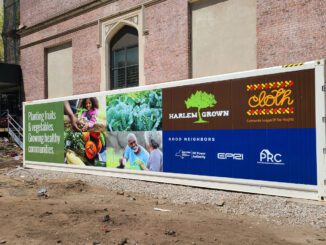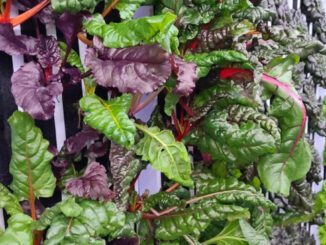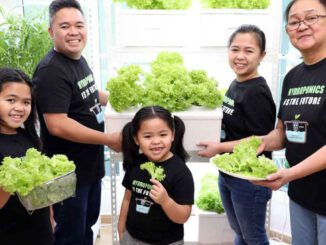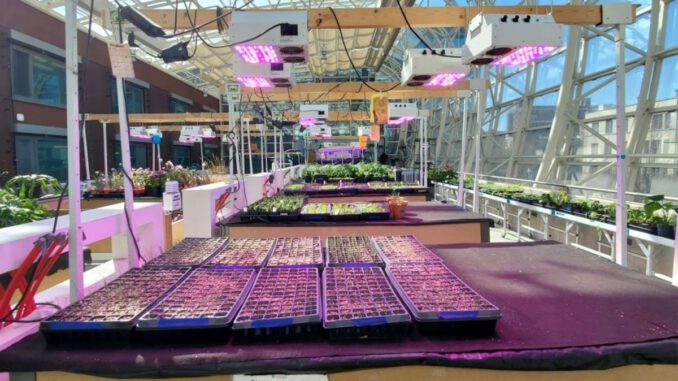
Loyola Chicago conference notes Gen Z’s role in securing food on warming planet
Gen Z & Agriculture | Brian Roewe |
IMAGE: Through the urban agriculture program at Loyola University Chicago, students harvest roughly 3,500 pounds of food a year, with 1,500-2,000 pounds going to food pantries. (NCR photo/Brian Roewe)
On the roof, in the lobby and elsewhere around the School of Environmental Sustainability at Loyola University of Chicago, students are growing lettuce, eggplant, tomatoes and more in bunches.
The hands-on learning labs of the Jesuit school’s urban agriculture program offer a glimpse into the future of farming. Just as critically, they reflect developing strategies to shift agriculture from an accelerant of climate change to a key mitigation tool, said Amanda Little, author of The Fate of Food: What We’ll Eat in a Bigger, Hotter, Smarter World, at the opening of Loyola Chicago’s annual climate change conference.
“The impacts of climate change on food production are evident everywhere,” she said in her keynote address March 14. “There are no regions of the world, no types of crops unaffected, and the pressures themselves are incredibly varied.”
As one U.S. Agriculture Department scientist told her, “The single biggest threat of climate change is the collapse of food systems.”
In face of that threat, Little said her years researching and reporting have revealed that solutions and innovations are growing, with younger generations of food producers and consumers playing an important role.
“Agriculture needs Gen Z. And Gen Z is beginning to transform and shift the definition of what agriculture can be,” Little said. (Gen Z typically refers to people born between 1997 and 2012.)
The focus of the two-day conference at Loyola Chicago was on climate change’s impact on global food production and security as well as strategies to develop equitable, resilient and sustainable food systems on a heating planet.
It’s through food that most people will experience the impacts of climate change, said Little, a journalism professor at Vanderbilt University. Rising temperatures are already disrupting global food production in ways that affect nearly every aisle of the grocery store.
In recent years, Citrus crops in Florida have been wiped out, as were peaches in Georgia. Hotter, drier conditions in California strained avocados and almonds. Excessive rains prevented potato harvests in Ireland. Coffee rust continues to damage coffee plants in Central America. Olive oil production declined in Spain as well as Italy, which also lost its title as top wine producer due to extreme weather. Drought and wildfires in the Pacific Northwest stressed hops production, a key ingredient in beer.
“Climate change is becoming something we can taste,” Little said. “This is a kitchen table issue in the literal sense.”
At the crux of the issue is a rising global population — and especially, an increasing middle class with diverse and protein-dense diets — while arable land globally is expected to decline 2% to 6% every decade due to stresses from climate change.
As climate change increases drought conditions and reduces crop yields, food insecurity is accelerating worldwide, with more than 600 million people lackingreliable food supplies, and 45 million people near famine.
The stresses that extreme heat and drought place on farming are felt most intensely by the 500 million smallholder farmers around the world, Little said, with the majority in already hot, dry countries along the equator.
A prediction in a 2014 report from the United Nations Intergovernmental Panel on Climate Change — global warming could reach a threshold where current agriculture practices can no longer support large human civilizations — led Little to pivot her reporting from energy to agriculture, investigating the “radical changes” in coming decades in the ways people grow and eat food.
Her reporting took her to apple orchards in Wisconsin, tiny cornfields in Kenya, Norwegian fish farms and “computerized foodscapes” in Shanghai. What she saw was the emergence of “a third way to our food future,” one which marries principles of old-world, organic agriculture with state-of-the-art farming technologies that have been at odds for decades.
“Agriculture, which has long been a driver of climate change, has the extraordinary advantage of being able to transform from sinner to saint,” she said.
Regenerative agriculture is improving soil health, allowing it to sequester more carbon — with the world’s farmlands capable of absorbing as much carbon as what’s emitted from the global transportation sector. Numerous ancient plants can withstand extreme climate conditions, as can crops designed through genetic modification and gene-editing tools like CRISPR.
Technologies like AI robotics and drones help reduce agrochemicals, and meat alternatives dramatically lower carbon emissions while freeing up land used for cattle grazing for reforestation, said Little, a self-described “failed vegan and struggling vegetarian.”
Along with increasing crop diversity, decentralizing food production is crucial to build more resilient food systems, she said. The growth in urban vertical farms, using hydroponic and aquaponic techniques like those taught at Loyola Chicago, can reduce water use by as much as 90% in some cases, while limiting food waste and greenhouse gas emissions from transporting food from fields to cities.
Asked how to accelerate U.S. agriculture toward more sustainable practices, Little said the answer was simple: Vote, especially among younger generations.
“We need good policies that support and encourage sustainable farming and that advance and protect local and regional food webs, which are totally overlooked, and the current Farm Bill,” she said.
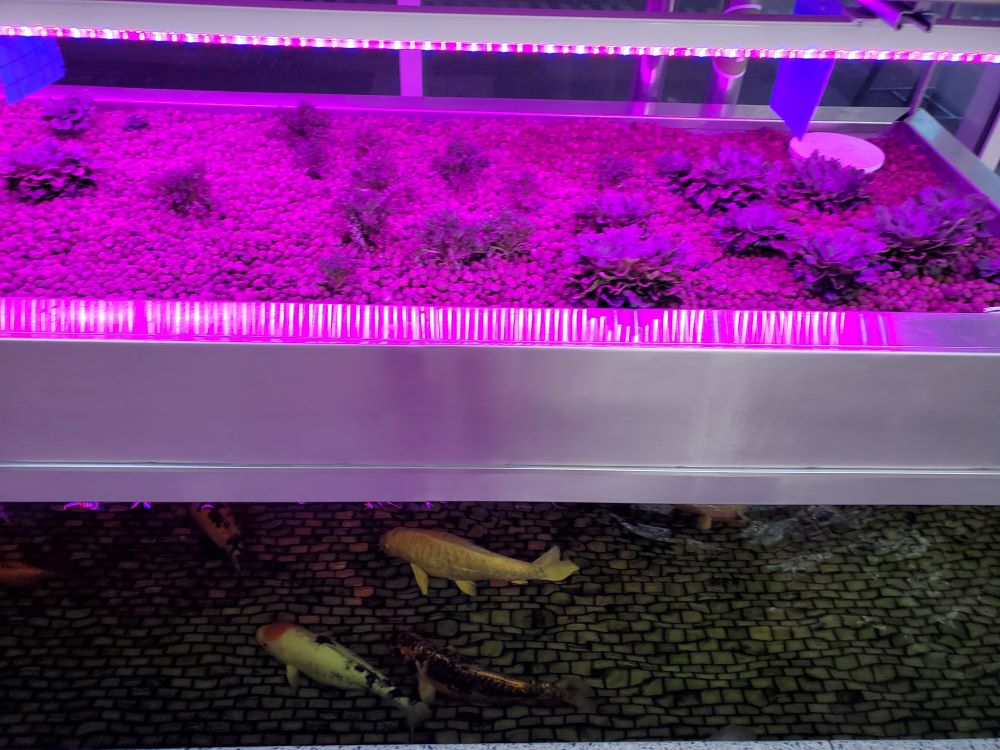
An aquaponics system at Loyola University Chicago’s School of Environmental Sustainability uses waste from fish to fertilize and grow plants and crops. (NCR photo/Brian Roewe)
On March 15, the conference’s second day, a series of panels further unpacked climate change’s impact on food at the global level, within the Midwest and in Chicago.
With an estimated 1,700 registrants, the ninth edition of Loyola Chicago’s climate conference was perhaps its largest yet.
In the past two decades, the Jesuit school has become a leading Catholic institution on environmental issues. To date, Loyola Chicago has cut campus carbon emissions 70% and expects to be carbon neutral by January 2025. A new university climate action plan will aim for decarbonization, or elimination of all fossil fuel use on campus.
The School of Environmental Sustainability enrolls more than 500 students in seven undergraduate programs and two master’s programs, with a number of them researching and experimenting with the future of how our food will be grown. Through its rooftop greenhouse and urban farm, students harvest roughly 3,500 pounds of food a year, with 1,500–2,000 pounds going to food pantries.
At the end of her talk, Little cited figures from the latest agricultural census that showed the average American farmer is 58 years old, up roughly six months from 2017. Farmers ages 65 and older increased by 12% over the same timeframe.
The conclusion was clear, she said: The farmers growing the food on dinner tables today are nearing the end of their careers.
“Agriculture needs Gen Z,” she added, noting that more first-generation farmers are entering the field — even if not a literal farm field but labs and facilities like those at Loyola Chicago.
“I think Gen Z has great promise to bring us into a new era,” Little said, “in which human innovation that marries new and old approaches to food production can, and I think we have good reason to believe will, redefine sustainable food on a grand scale.”
Original Article Here: https://www.ncronline.org/earthbeat/loyola-chicago-conference-notes-gen-zs-role-securing-food-warming-planet

